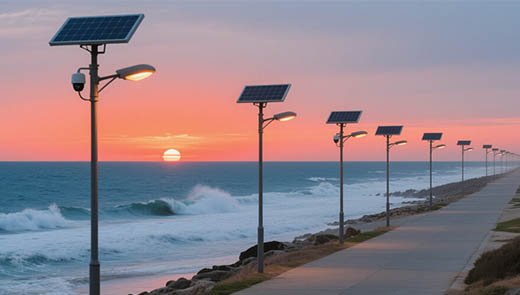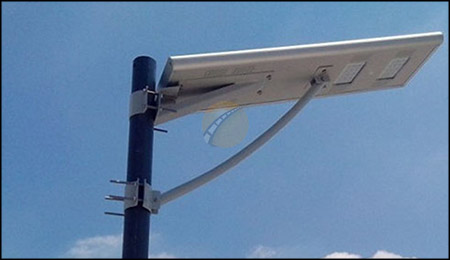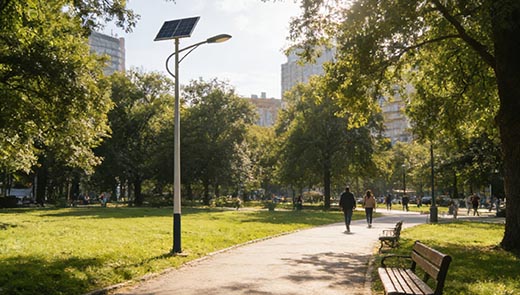Solar Road Stud Lights: Illuminating Roads in the Philippines
The Philippines' geography and climate, with over 7,000 islands, pose challenges for road infrastructure. 63% of roads lack effective lighting, resulting in a 37% higher accident rate at night. Typhoons cause a 42% damage rate to traditional lighting systems, and remote islands have less than 40% grid coverage. Solar road studs, with their “off-grid power supply and smart sensing” features, have been incorporated into the Philippines' green infrastructure plan. Their visibility of 200 meters in rain and fog is four times that of traditional road studs, aligning with local climate conditions and zero-carbon lighting requirements.
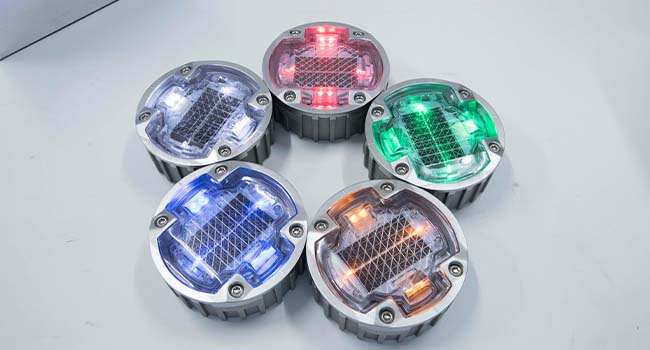
What are Solar Road Studs?
Traditional road studs, which have been in use since the 1930s, rely on rubber-coated glass beads for reflective material. Their operational mechanism requires vehicle crushing to trigger an internal cleaning mechanism, and their nighttime visibility is limited to 50 meters due to the angle of vehicle headlights. Solar road studs achieve innovation through three technological breakthroughs:
Energy conversion system: Utilizing monocrystalline silicon photovoltaic panels (conversion efficiency 18%-22%), under the Philippines' average annual sunlight hours of 2,000, a single day's effective charging can support 72 hours of continuous illumination.
Intelligent control system: Integrated with a photoresistor and MCU chip, the LED automatically activates when ambient light intensity falls below 200 lux. Combined with PWM pulse width modulation technology, it achieves three-level power consumption regulation: “high light - low light - sleep mode.”
Structural Protection System: The housing is made of ABS+PC alloy with added nano-zinc oxide (UV resistance grade 5), and the interior is sealed with silicone rubber for waterproofing, meeting IP68 protection standards. It can withstand 30 tons of crushing and the impact of a Category 12 typhoon.
The working principle of solar road studs
The working principle of solar road studs revolves around the utilization of solar energy and intelligent control. During the day, the solar panels absorb sunlight and convert it into electrical energy, which is stored in the battery, ensuring continuous illumination even during prolonged periods of cloudy or rainy weather. As light levels decrease in the evening, the built-in sensors automatically activate the LED lights, emitting light to clearly outline the road contours.
The core principle of solar road studs is to convert solar energy into electrical energy for recycling, and they can operate autonomously without an external power supply. Through light-sensing components, they achieve intelligent switching between “daytime charging and nighttime illumination,” providing continuous lighting for roads under various conditions and effectively enhancing driving safety.
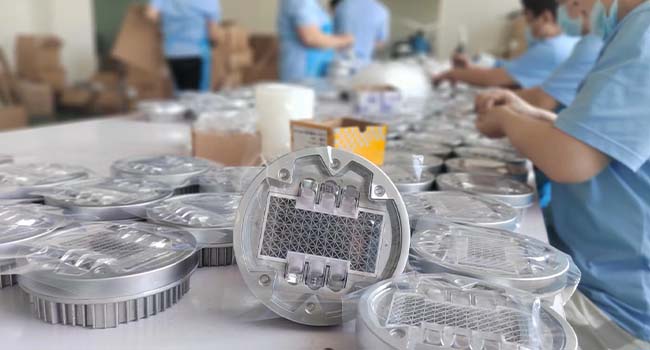
Advantages of Solar Road Studs in the Philippines
Enhancing Visibility
The Philippines experiences over 200 rainy days annually, with rain and fog reducing the reflective efficiency of traditional reflective road studs by 70%, making them a primary cause of nighttime accidents. Solar road studs utilize encapsulated LED chips, emitting 6500K cool white light with significant penetration through rain and fog. Their luminous flux reaches 80-100lm. In a field test conducted during a heavy rainstorm in Mindanao Province, visibility retention at a 200-meter distance reached 92%. Compared to the 50-meter passive reflective distance of traditional road studs, their active lighting mode establishes a 4-times safer viewing distance in tropical monsoon climates. Especially on mountainous roads in Luzon Island at night, they can provide a 10-second advance warning of curve hazards, significantly increasing drivers' reaction time.
Guiding Traffic Flow
In urban core sections of cities like Manila and Cebu, where traffic volume is high and congestion is severe, the solar-powered road studs integrate microwave radar sensors to intelligently adjust lighting modes based on traffic speed. When slow traffic is detected, the system automatically switches to a high-frequency flashing mode to guide vehicles to change lanes. In the Makati Central Business District, the road studs also integrate with pedestrian detection systems. When pedestrians crossing the street are detected, the system sends warnings to vehicles via flashing lights and V2X technology. This technical logic is highly suited to the “high-density, mixed-traffic” road characteristics of Philippine cities.
Promoting Sustainable Transportation
The Philippines' Renewable Energy Act requires that 50% of energy come from clean sources by 2030. Solar road studs emit only 12.6 kg of carbon per unit over their entire lifecycle (8 years), a 91% reduction compared to traditional solutions, fully meeting the DPWH green tender scoring criteria (3 points per unit). Fifteen percent of the government's annual infrastructure budget is allocated specifically for low-carbon technologies, and this product is eligible for a 15% investment tax credit under the Green Infrastructure Incentive Act. For example, installing solar road studs on a 100-kilometer highway could reduce carbon emissions by 1,200 tons annually, equivalent to planting 60,000 Norfolk pines. This not only aligns with the Philippines' national commitment to address climate change but also creates additional economic value through carbon trading.
Empowering Rural Communities
In the mountainous regions of Mindanao, 38% of villages lack grid coverage. Traditional lighting infrastructure installation costs as high as ₱120,000 per kilometer, while solar road studs use an independent power supply system with installation costs of only ₱35,000 per kilometer. In a rural project in Pangasinan Province, road stud lighting increased nighttime agricultural product transportation efficiency by 60% and reduced wastage rates from 25% to 9%. Their “plug-and-play” feature has completely resolved the power supply challenges posed by the geographical isolation of the Philippine archipelago, particularly in remote areas like Bohol Island and Negros Island, where continuous lighting networks can be established without grid connection, filling the safety gap in rural road infrastructure.
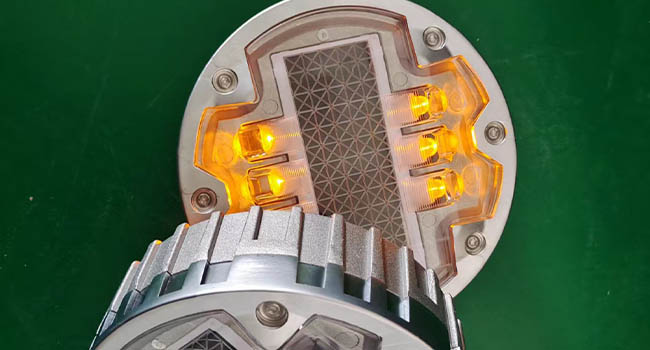
Resilience in Adverse Conditions
The Philippines experiences over 20 typhoons annually, with Typhoon “Bavi” in 2023 causing over 100,000 damages to national road lighting facilities. The solar road stud housing is made of ABS+PC alloy with a Shore hardness of 90A, featuring an impact resistance strength of ≥50 kJ/m². It has passed ISTA 3A transportation testing and a 96-hour salt spray test (5% NaCl solution). Following Typhoon “Rui” in 2024, sampling inspections revealed that 98% of the equipment remained fully functional. With an IP68 waterproof rating, they can withstand immersion in 1.5 meters of water for 72 hours and deformation rates of less than 0.5% under 30-ton crushing tests. Their technical parameters are fully compatible with the Philippines' island climate characterized by “high salt fog, strong impact, and heavy rainfall,” reducing maintenance costs by 71% compared to traditional facilities.
Application of Solar Road Studs in the Philippines
Solar Stud Light Philippines Highways and Expressways
On the vast highways and arterial roads connecting the islands, underground embedded solar road studs mark lane boundaries at precise intervals, providing clear guidance to drivers through continuous active lighting day and night. Their built-in light-sensing system automatically switches operating modes based on ambient brightness. In rainy or foggy weather, their penetrating bright light effectively extends visibility. Combined with geomagnetic sensor technology, they monitor real-time traffic speeds and automatically adjust flashing frequencies when congestion occurs, significantly reducing the risk of rear-end collisions at night.
Urban Roads and Intersections
On bustling urban roads and busy intersections, aluminum flashing LED solar road studs significantly enhance road visibility with their high-brightness light sources. Especially in densely trafficked areas like Manila and Cebu, the road studs are deeply integrated into intelligent traffic signal systems, enabling real-time data interaction via IoT technology. During peak hours, the road studs automatically switch to dynamic flashing modes based on traffic density and signal light changes, guiding vehicles to travel in orderly lanes. In pedestrian crossing areas, the road studs closely coordinate with the zebra crossing warning system. When pedestrians are detected approaching, the warning lights are immediately activated, and warning signals are sent to passing vehicles, significantly reducing the incidence of pedestrian-vehicle collisions and weaving a safety net for urban traffic.
Coastal Roads and Waterfronts
Embedded solar road studs are widely used on coastal roads and scenic waterfront sections in the Philippines. Considering the characteristics of the marine climate, such as strong salt fog corrosion and high humidity, the road studs feature a 316L stainless steel base resistant to salt fog corrosion, paired with a fluorocarbon-coated shell, offering excellent corrosion resistance and anti-aging performance. In areas such as Boracay Island and Cebu Waterfront Avenue, the road studs not only provide stable and safe lighting for vehicles at night to ensure driving safety but also use soft, continuous light strips to elegantly outline the winding coastline, creating a unique light and shadow landscape in the darkness, seamlessly blending road safety with the romantic coastal scenery.
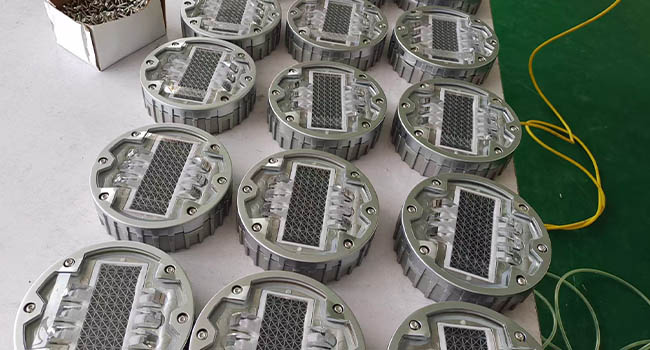
Mountainous Terrains
In typical mountainous regions of the Philippines, solar road studs adapt to slopes ranging from 15° to 45° via adjustable tilt brackets, ensuring efficient absorption of sunlight by the photovoltaic panels. The matching heating modules automatically dispel fog from the lens surface during the rainy season. In winding mountain roads like the Cordillera Mountains, the road studs use high-brightness light sources to clearly mark the boundaries of curves, addressing the challenge of lighting blind spots on mountain roads.
Tourist Destinations
In popular tourist destinations like Boracay, Palawan, and Cebu, Philippine aluminum solar road studs create a safe and comfortable nighttime travel environment with warm white light. They not only ensure the traffic safety of tourists and local residents but also form a “starry sky highway” landscape through the regular arrangement of light bands, becoming a distinctive tourist attraction and indirectly driving the economic development of the surrounding tourism industry.
Remote Rural Areas
In remote rural areas with scarce traditional power lighting resources, solar road studs leverage their unique off-grid power supply capability to serve as “beacons of light” safeguarding road safety. Especially in regions like Mindanao Island and Negros Island, where grid coverage is below 40%, these road studs can provide continuous lighting without relying on municipal grid connections. This feature not only significantly reduces the time villagers spend traveling at night but also markedly enhances the safety of medical supply transportation in remote areas, establishing a robust road safety barrier for local livelihood protection.
Industrial Zones and Commercial Hubs
In economically active industrial zones and commercial centers, high-brightness LED solar road studs provide precise route guidance for heavy-duty transport vehicles. Their high-strength structure, capable of withstanding 30 tons of pressure, and IP68 waterproof design adapt to the frequent heavy traffic and complex operational environments of industrial zones, effectively reducing the risk of operational accidents involving forklifts, trucks, and other large vehicles, thereby ensuring the safety of workers and commuters.
Solar road studs utilize a closed-loop system combining photovoltaic power generation, energy storage, and intelligent control to effectively address lighting challenges caused by insufficient grid coverage and frequent extreme weather in the Philippines, ensuring road safety in tropical regions. Their lifecycle costs are significantly lower than traditional solutions, with minimal annual maintenance expenses, aligning with the Philippines' limited infrastructure budget. From an environmental perspective, promoting solar road studs can significantly reduce carbon emissions, supporting the Philippines' emissions reduction goals.

